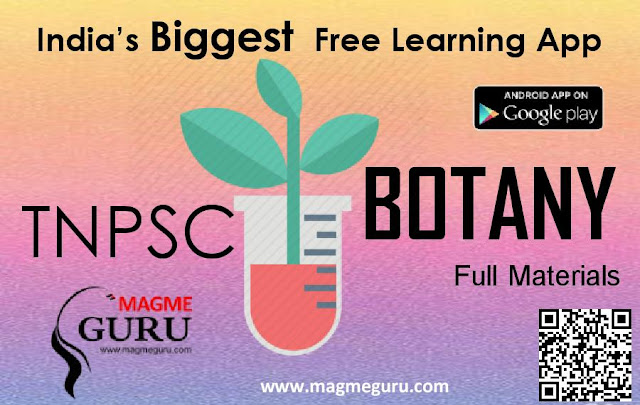BOTANY - NUTRITION & DIETETICS
- (UPSC,TNPSC,TRB Imporatant Notes)
NUTRITION
• It is the process to intake different nutrients (Carbohydrates, Proteins, Vitamins, Minerals etc.) to maintain different life process such as growth, repair etc. Nutrients are the source of energy for different metabolic (energy-giving) processes.
PLANT NUTRITION
Plant nutrition is a study of the elements and compounds that are necessary for its growth. There are mainly two types of nutrition in plants.
• Autotrophic
• Heterotrophic
1. AUTOTROPHIC
• Autotrophs are organisms that can synthesize (make internally) their own food.
• Examples of autotrophs are most species of plants and unicellular organisms.
• Autotrophic plans are those that make their own food through a process called photosynthesis.
• In photosynthesis, plants possessing chlorophyll (the cells that give leaves their green colour) synthesize simple sugar (glucose).
• They do it using water and CO2 and in the presence of sunlight.
• There are some autotrophic plans conducting photosynthesis through chlorophyll though they do not appear green in colour.
2. HETEROTROPHIC
• Heterotrophs are organisms that are dependent on others for their food.
• Some examples of heterotrophs are fungi, bacteria etc. Some plants are also heterotrophs.
• They survive by consuming animals, dead things and nutrients from other plants. E.g. Venus Flytraps, Pitcher Plants, Rafflesia and other parasitic plants.
ANIMAL NUTRITION
1. HOLOZOIC
• Such an animal will engulf, digest and absorb the food itself. These animals are divided into 3 types:
I. Herbivores: Animals that eat plants only (e.g. Cow, Goat etc.)
II. Carnivores: Animals that eat other animals (e.g. Tiger, Viper, Spiders etc.)
III. Omnivores: Animals that eat both animals and plants (e.g. Human Beings, Ants etc.)
2. PARASITES
• Parasites live on or inside other living organisms. In this type, one animal is dependent on other animals for nutrition. The animal that is dependent is called parasite and on whom it is dependent is called host.
3. SAPROZOIC
• Animal that extracts its food from the rotten substances. Example is insects that survive on dirty drainage etc.
NUTRIENTS ABSORBED BY ANIMALS
1. Carbohydrates
• They are the organic compounds in which C, H, O are often present in 1:2:1 ratio.
Functions:
• Provide energy especially for the brain.
• Regulation of blood glucose.
• Breaking down fatty acid.
• Dietary fibre etc.
Sources: Wheat, rice, potato, plants etc. Mainly present in the form of sugar, starch and cellulose.
2. Proteins
• These are the nitrogenous substances which are called building blocks of the body. One or more long chains of amino acids form proteins. Nitrogen along with C, H, and O are present in proteins.
Functions:
• Essential for formation and growth of cells & tissues etc.
• Vital in the maintenance of body tissue, including development and repair.
• Provide energy to the body.
• Acts as enzyme.
• Helps in developing genetic characteristics.
Sources: Meat, fish, eggs, beans, yogurt, lentils, soy etc.
Diseases:
• Kwashiorkor: Caused by deficiency of proteins in diets with calories mostly from carbohydrate
sources like rice and bananas. Children develop thin arms and legs with swollen stomach. They have stunted growth, diarrhoea, fatigue etc.
• Marasmus: Caused by severe deficiency of proteins and calories in infants. Muscle tissue and
water content reduced. Causes starvation.
3. Fats:
• Saturated esters of glycerol and fatty acids.
Functions:
• Provide energy.
• Protects organs from injuries.
• Protects skin from losing heat.
Sources: Animal fats are saturated in nature and found in milk, meat, cheese, butter etc. They are also found extensively in red meat. Vegetable fats are trans-saturated and their sources are nut, coconut, mustard, almond etc.
Diseases: Over consumption and excessive presence of fat can cause heart disease and high blood pressure.
4. Vitamin
• Vitamins are vital amino acids. These organic compounds are required in very small quantities for our body. There are two types of vitamin based on their solubility:
A. Soluble in water: Vitamins B and C
B. Soluble in fat: Vitamins A, D, E and K
5. Water:
• It is the most essential component of our body. Around 70% weight of our body is water. It controls the body temperature, regulates biochemical reactions etc.
6. Minerals:
• Minerals are homogeneous inorganic materials which controls the metabolism of our body. Below are some important minerals and their functions:
• It is the most essential component of our body. Around 70% weight of our body is water. It controls the body temperature, regulates biochemical reactions etc.
6. Minerals:
• Minerals are homogeneous inorganic materials which controls the metabolism of our body. Below are some important minerals and their functions:












Develop Healthier tomorrow with 40% Off on our Nutrition and Dietetics Course For more information on our courses visit www.vlccinstitute.com & to register click https://bit.ly/VLCC-Online
ReplyDelete